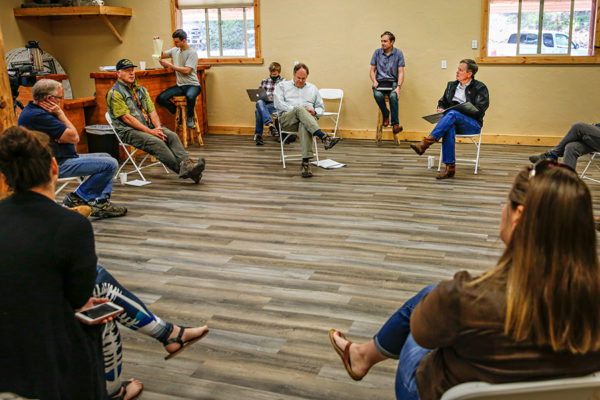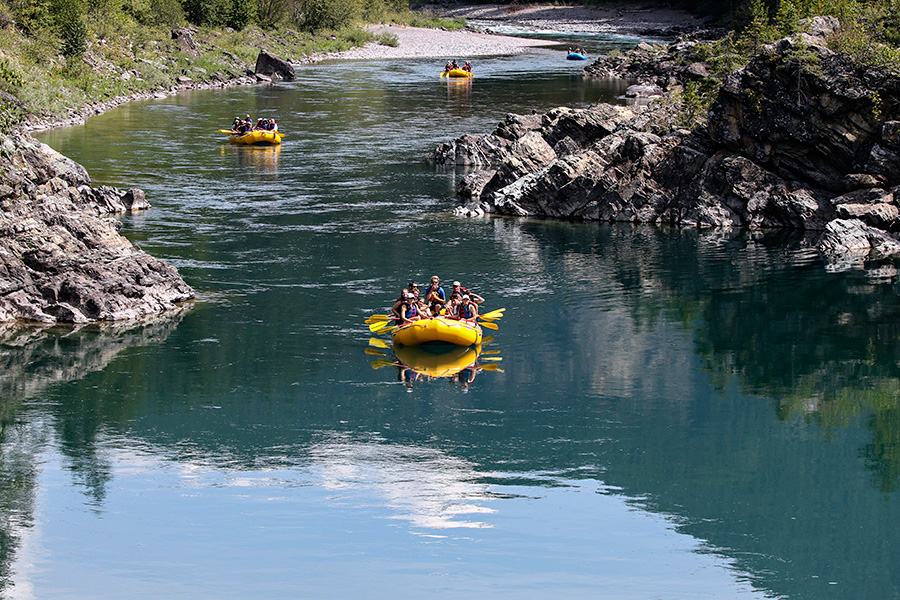In communities flanking Glacier National Park, small business owners and major employers alike play a guessing game each year as to when the park’s alpine highway, the famed Going-to-the-Sun Road, will be cleared of snow, allowing visitors to traverse the park’s wild interior by motor vehicle while signaling the unofficial start of tourism season.
Then it’s a question of hell or high water, as spring runoff causes rivers to rise while also providing one predictive measure for gauging the severity of wildfire season — heavy runoff in May or June can alleviate the smoke of forest fires in July, but those just-plowed roads might be submerged in murky snowmelt.
“It’s always a balancing act,” says Monica Jungster, owner of the Montana House, a gift shop operating at Apgar Village, just inside Glacier National Park’s west entrance.
Doing business in and around Glacier National Park means grappling with forces unknown, with so many eggs squeezed into one small, seasonal basket teetering on a knife’s edge.
As one of the few businesses operating year-round in the park, Jungster is accustomed to the boom-and-bust rhythms of a seasonal economy, as well as the unpredictable nature of nature. But as COVID-19 continues rearranging these norms and eroding the foundation of a tourism-based economy, Jungster has thrown her expectations out the door, flexible as they already are.
“I know what to do with fires. I know what to do with floods. I don’t know what to do with this,” Jungster, who has been featuring the work of local artists and authors for 60 years, said of the pandemic. “I never anticipated my 60th anniversary to be like this.”
Glacier National Park has been closed since late March, and while its federal administrators are laying plans to coordinate a reopening with state, county and tribal officials, they still hadn’t announced a date as of June 1 — the same day that Montana entered its second phase of reopening. (Glacier has since announced a limited reopening on June 8.)

Meanwhile, gateway businesses from West Glacier to Essex are straddling a jurisdictional divide, anxiously awaiting an announcement from Glacier Superintendent Jeff Mow, who himself is engaged in a balancing act involving the interests of more than two dozen businesses pressuring him to reopen, as well as the state of Montana, county health officials and the Blackfeet Nation, whose reservation spans the park’s eastern boundary and remains closed to non-essential travel.
Businesses most dependent on summertime tourism include outfitters offering horseback rides and rafting trips to visitors, as well as lodges and event venues that take reservations up to a year in advance, not to mention the breweries and distilleries, restaurants and gift shops that depend on a steady stream of summer tourism.
Brian Kelly, who owns the historic Izaak Walton Inn near Essex and Eddie’s Café in West Glacier’s Apgar Village, said he’s frustrated by what he sees as disparities in how individual units of the National Park Service have responded to the coronavirus pandemic, with some parks reopening sooner than others.
“I’ve lost 22 weddings this summer and a lot of reservations,” Kelly said of his bookings at the Izaak Walton. Meanwhile, he said, other parks like Yellowstone and Teton national parks, as well as their adjacent business communities, are “open and flourishing.”
“At what point will the Interior Department say this is not appropriate?” Kelly asked during a May 29 roundtable discussion with U.S. Sen. Steve Daines.
According to Daines, a Republican running for reelection, he’s spoken directly to Interior Secretary David Bernhardt about the critical role Montana’s national parks play in gateway economies.
“He’s yielding to the states and even to the counties,” Daines said, emphasizing that he’d push for a specified opening date in Glacier. “I know it’s been tough times. We should be using common sense and move forward with safe, phased reopenings, and get a date certain here for Glacier.”
While Glacier Park officials have not announced a specific date to reopen the west entrance, they have released details of a phased plan that would initially provide access to the Going-to-the-Sun Road from the West Glacier entrance to the closure at Avalanche Campground. Hiker and biker access would be allowed beyond the gate as plow crews work to clear the entirety of the road to Logan Pass.
Glacier’s eastern entrances (St. Mary, Many Glacier and Two Medicine) lie on the Blackfeet Indian Reservation and will remain closed until the Blackfeet Tribal Business Council lifts its prohibition on non-essential travel, which the Tribe extended until June 30.
Jack Gladstone, a Blackfeet musician who for more than three decades has been bringing his “Native America Speaks” series to Glacier National Park, urged patience with the tribe as Blackfeet leaders work to protect a community and a culture with different needs and resources.
“It’s like that scene in ‘Jaws’ where the summer tourists arrive and everyone flocks to the beach,” Gladstone said. “The word of warning is the shark is still there and ready to be active, and if and when that happens we will reassess the mistakes we made.”
“Try to harmonize with our tribe, because we have done some very progressive mature things,” he added.
Jungster, whose gift shop depends on walk-in customers, said her summer hinges on the park’s opening date, but so does her health, as well as that of her employees, many of whom are over the age of 60.
“I’m just one gift shop, but I’m right inside the park,” she said. “So when the park opens, and it will, I hope there are some strong safety measures in place.”
